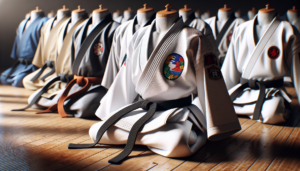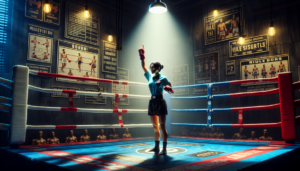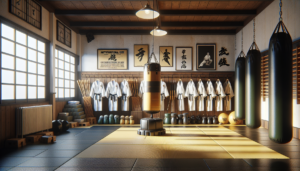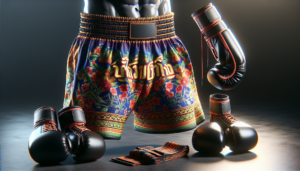Introduction to Dojo in Karate
In the world of martial arts, the term “dojo” holds a special significance, particularly in the context of karate. A dojo is not merely a physical space where training takes place; it embodies a deeper meaning and purpose that goes beyond the walls of the training hall. Understanding what a dojo represents in karate is essential for practitioners to fully embrace the art’s principles and values.
Definition of a Dojo
The word “dojo” is of Japanese origin, translating to “place of the way.” In karate, a dojo refers to the training space where students, known as karateka, gather to practice and learn the art under the guidance of a sensei (teacher). The dojo serves as a sanctuary for karateka to cultivate their skills, strengthen their minds and bodies, and immerse themselves in the rich tradition of karate.
A dojo is more than just a gym or a workout facility. It is a place where respect, discipline, and dedication are paramount. The atmosphere within a dojo is one of focus and reverence, fostering an environment conducive to personal growth and the transmission of karate’s teachings from one generation to the next.
Historical Background of Dojos
The concept of the dojo has its roots in ancient Japan, where martial arts were practiced in secluded spaces, often within temples or private residences. These early dojos were not only training grounds but also places of spiritual cultivation and character development. As karate evolved and spread beyond Japan’s borders, the tradition of the dojo remained an integral part of the art, preserving its essence and values.
Today, karate dojos can be found all around the world, each with its own unique flavor and interpretation of the art. However, the core principles and the profound meaning of the dojo remain constant, connecting karateka across cultures and continents.
The Purpose of a Dojo in Karate
The purpose of a dojo in karate extends far beyond being a mere training space. It serves as a hub for personal development, community building, and the preservation of karate’s rich heritage.
Training and Practice
At its core, a dojo provides a dedicated space for karateka to engage in regular training and practice. It is where students learn and refine techniques, develop their physical abilities, and cultivate mental discipline. The dojo environment is designed to minimize distractions and create a focused atmosphere that allows karateka to fully immerse themselves in their training.
The physical layout of a dojo often includes a training area with mats (tatami) for safe practice, a designated space for the sensei, and areas for students to line up and bow. This structured environment instills a sense of order and respect, reinforcing the importance of discipline and etiquette within the art.
Community and Discipline
Beyond its function as a training space, a dojo also serves as a community hub for karateka. It is a place where practitioners of all levels come together to share their passion for the art, support one another’s growth, and forge lasting bonds of friendship and camaraderie.
The dojo environment fosters a sense of belonging and unity among its members. Karateka learn to work together, encourage each other, and uphold the values of respect, humility, and perseverance. This communal aspect of the dojo plays a vital role in the holistic development of karate practitioners, both on and off the mat.
Moreover, the dojo instills discipline and builds character. Through consistent training, adherence to etiquette, and the guidance of the sensei, karateka learn valuable life skills such as self-control, patience, and resilience. The dojo becomes a crucible for personal growth, helping individuals develop not only as martial artists but also as well-rounded human beings.
Core Principles and Values of a Dojo
The core principles and values upheld within a karate dojo shape its culture and define the essence of the art. These principles serve as a guiding light for karateka, influencing their behavior, attitudes, and approach to training.
Respect and Etiquette
Respect is a fundamental tenet of karate, and it permeates every aspect of the dojo experience. Karateka are taught to show respect to their sensei, their fellow students, and the dojo itself. This respect manifests through proper etiquette, such as bowing upon entering and leaving the dojo, addressing the sensei appropriately, and treating others with kindness and humility.
The practice of etiquette in the dojo goes beyond mere formalities; it cultivates a mindset of reverence and gratitude. By adhering to these protocols, karateka learn to value the knowledge and guidance they receive, appreciate the efforts of their training partners, and maintain a humble and respectful demeanor both within and outside the dojo.
Self-Discipline and Personal Growth
The dojo environment places a strong emphasis on self-discipline and personal growth. Karateka are encouraged to push their limits, overcome challenges, and strive for continuous improvement. Through rigorous training and the guidance of the sensei, students develop mental and physical fortitude, learning to persevere through adversity and maintain focus in the face of distractions.
The dojo becomes a catalyst for personal transformation, helping individuals cultivate qualities such as patience, determination, and self-control. These skills extend beyond the confines of the dojo, empowering karateka to face life’s challenges with greater confidence and resilience.
Moreover, the dojo promotes the idea of karate as a lifelong journey of self-discovery and growth. It encourages practitioners to embrace the process of learning, to remain humble and open-minded, and to continually seek opportunities for self-improvement. This mindset fosters a sense of personal responsibility and accountability, as karateka recognize that their progress and development lie in their own hands.
The Dojo Environment
The physical environment of a karate dojo plays a crucial role in creating an atmosphere conducive to training and personal growth. The layout, equipment, and the roles of the sensei and sempai (senior students) all contribute to the overall dojo experience.
Physical Layout and Equipment
A typical karate dojo features a clean, uncluttered space with a training area covered in mats (tatami). The mats provide a safe and comfortable surface for practicing techniques, allowing karateka to move freely without the risk of injury. The dojo may also include a designated area for the sensei, often marked by a small altar or a portrait of the style’s founder.
Other common elements in a dojo include a punching bag or makiwara (striking post) for practicing strikes, as well as mirrors along the walls to help students refine their techniques and posture. The dojo may also display traditional Japanese calligraphy or scrolls with karate principles, serving as reminders of the art’s values and philosophy.
Role of Sensei and Sempai
The sensei, or instructor, plays a pivotal role in the dojo. As a knowledgeable and experienced practitioner, the sensei guides students in their training, imparting both technical skills and the philosophical principles of karate. The sensei sets the tone for the dojo, leading by example and fostering an environment of respect, discipline, and dedication.
Sempai, or senior students, also play an important role in the dojo hierarchy. They assist the sensei in teaching and mentoring junior students, providing guidance and support. Sempai serve as role models, demonstrating the proper etiquette, technique, and spirit expected of karateka. Their presence helps maintain the continuity of knowledge and tradition within the dojo.
The relationship between sensei, sempai, and students forms the backbone of the dojo community. It is built on trust, respect, and a shared commitment to the art of karate. This hierarchical structure ensures the transmission of knowledge and values from one generation to the next, preserving the essence of the art.
Cultural Significance of Dojos
Beyond their practical function as training spaces, dojos hold deep cultural significance within the world of karate. They serve as repositories of tradition, rituals, and the intangible aspects of the art that shape the karateka’s journey.
Rituals and Traditions
Karate dojos are steeped in rituals and traditions that connect practitioners to the art’s rich history and cultural roots. These rituals may include the practice of bowing upon entering and leaving the dojo, the recitation of the dojo kun (a set of guiding principles), and the observance of certain protocols during training sessions.
These rituals serve as a reminder of the respect and humility that are central to karate. They help create a sense of reverence and sacredness within the dojo, reinforcing the idea that karate is not merely a physical pursuit but a holistic practice that encompasses the mind, body, and spirit.
Impact on Practitioners
The cultural significance of the dojo extends beyond the physical space and into the lives of karateka. The lessons learned and the values instilled within the dojo have a profound impact on practitioners, shaping their character and influencing their actions outside the training hall.
The discipline, respect, and perseverance cultivated in the dojo translate into various aspects of life, from personal relationships to professional endeavors. Karateka carry the principles of the dojo with them, applying them to overcome challenges, make ethical decisions, and contribute positively to their communities.
The dojo also provides a sense of belonging and identity for karateka. It becomes a second home, a place where individuals can find support, guidance, and a shared sense of purpose. The bonds formed within the dojo often extend beyond the training sessions, creating lifelong friendships and a network of support.
Conclusion
In conclusion, understanding what a dojo represents in karate is essential for practitioners to fully embrace the art’s essence and potential for personal growth. A dojo is more than just a physical space; it is a sanctuary where respect, discipline, and dedication converge to create an environment that nurtures the mind, body, and spirit.
Through the guidance of the sensei, the support of the dojo community, and the adherence to core principles and values, karateka embark on a transformative journey of self-discovery and development. The dojo becomes a catalyst for personal growth, empowering individuals to face challenges with confidence, resilience, and a profound sense of purpose.
As karateka step into the dojo, they enter a realm steeped in tradition, ritual, and the timeless wisdom of the art. They become part of a lineage that spans generations, connected by a shared passion for karate and a commitment to the values it embodies. The dojo, in its essence, is a sacred space where the past, present, and future of karate converge, guiding practitioners on their path to mastery and self-realization.
#EN#






